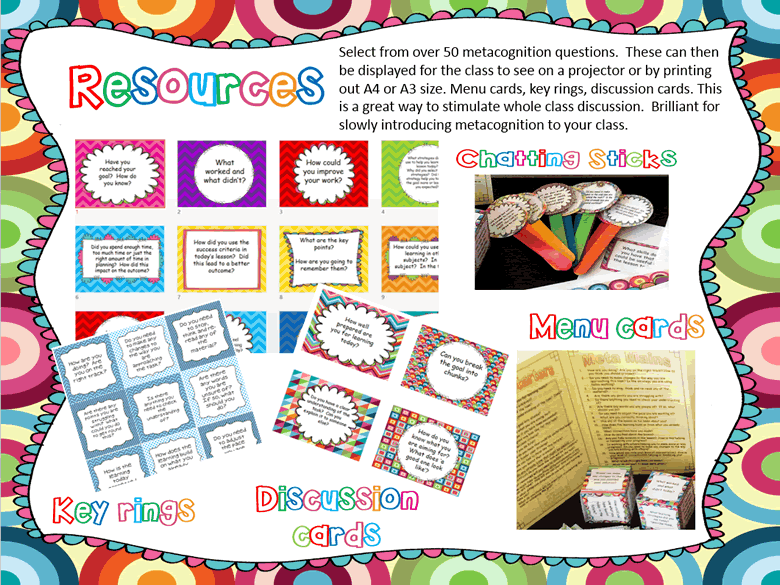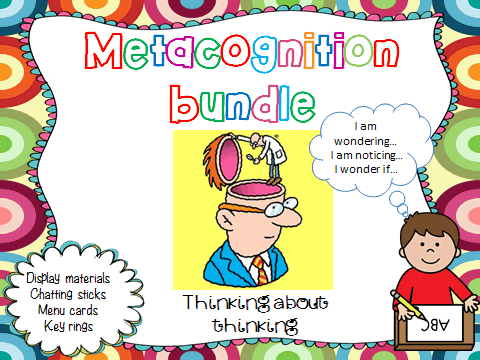Developing metacognition in your school
Plan - Monitor - Check
Successful students ask themselves thousands of questions as they study. These resources help pupils to develop the internal dialogue and questioning skills they need to have at each stage of producing a piece of work. Plan - Monitor - Check.

PMC: a practical approach
Three useful ways to support learners to direct their own learning involves helping them to learn skills in the following categories PMC:
Plan for a learning tasks: identify the problem, choose strategies, organise their thoughts, and predicting outcomes. If we want pupils to become more independent and more effective learners, we need to instruct them on strategies and model thinking processes. How do you take a task and break it into parts? How do you decide how long to spend on each element? How do you draw on previous experiences to help you plan and approach to a task? How do you decide if working alone, in a pair or as part of a group would be the best way to complete the task? Will it be possible to complete the task in one sitting, or might you need to come back to the task several times during the week/term? What type of planning might be effective?
We need to teach pupils planning strategies, help them to evaluate their planning and teach them how to USE their planning.
Build time into lessons on a regular basis to reflect on 'how effective was I in preparing for the task?'
Monitor thought processes during a learning task: consider if their approach is effective, are on the right track, are any corrective measures needed, do they need to revise the work and adjust their approach? Considering questions such as : Do I understand it so far? Do I need to ask a question? Am I on the right track? Am I still on task? Is there a better way? Do I need to re-read that section? Metacognitive learners ask themselves hundereds of questions in their heads as they complete the task. They often look at what others are doing and check against any success criteria or model of good practice. Pupils who are less metacognitive are just not aware of the types of questions good learners are considering and how successful learners change their approach as they work in light of reflective thinking or feedback from others. We can help pupils by providing questions that will aid reflective thinking and we can model the process for learners to see.
Check outcomes: evaluate the outcomes/learning objectives against specific criteria, consider what went well and how learning could be improved, consider the approach they took to achieving their goal and if it was effective. Answering questions such as : How did I do it? What method/strategy worked? What did I learn? Did my plan work out? Can I learn from my mistakes? Can I do better next time? At the end of a unit of work, learners need to consider both the quality of the 'product' they have produced but also how they approached the task. What were the variables involved from start to finish and what changes would they make if starting the process again?
Highly metacognitive pupils have a well developed internal dialogue and reflect on their progress. These are the the pupils who are asking themselves questions before the task starts, such as: What is the success criteria? Do I understand the task? How long do I think it will take? Are there any parts of the task that look tricky? Have I done something like this before? They are asking themselves questions during the task, such as: How much progress am I making? Am I on the right track? Do I need to speed up or slow down? Do I need to re-read that last paragraph? And they are asking themselves questions after the task, such as: Did I meet all of the criteria? Did I make good use of time? If I were to do this task again, what would I change?
As pupils adopt more self-monitoring skills and develop the internal dialogue needed for planning / task analysis, monitoring and evaluating, the more control is seen in areas previously externally directed by teachers and parents. We can help pupils to develop the self-monitoring, self-questioning and internal dialogue needed to be more independent and successful learners.

We can help pupils to develop this internal dialogue. We can support their thought processes until they can ask themselves these types of questions automatically. We can do this by modelling the process, using 'think alouds' and by providing question prompts to aid discussions.
Modelling the thought process & thinking aloud
Effective think-alouds involve demonstrating whilst voicing aloud all your thought processes. Not just ‘how’ to do something, but the internal narrative that matches the demonstration. Think-alouds show pupils how you have arrived at decisions, reasons for actions, insights into how to complete the task successfully, pitfalls to avoid, how to correct mistakes, etc. They should show your thinking very clearly allowing the pupil to see the metacognitive processes at work.
Pupils often believe, incorrectly, that an expert’s thinking is always assured, linear, correct and unswerving. When they gaze on their teacher as she completes a quadratic equation, they can’t see that, inside her head, she is rapidly entertaining and discarding possible ways to factor, isolate the coefficients, and such. All they see is the teacher flawlessly executing yet another difficult problem. Pupils ask themselves : “How can I possibly do this?”
Example of a think-aloud
The following is of a teacher who has begun a watercolour painting unit. She knows her pupils need to learn how to stretch their watercolour paper correctly in order to have a satisfactory result with their end product. She begins by naming all the materials she will need for the task, including the paper, art tape, clean water and two sponges, and a board for mounting paper. Next she talks through the process:
“The first thing I need to do is check to make sure I have the side of the paper I want to use facing up. I can paint on either side, but I like to use the rougher side of the paper because it seems to hold my paint better. I can run my hand over both sides of the paper to figure out which side is rougher. The paper needs to soak in water for a few minutes, so I am going to place it in the pan and set the timer for three minutes. That way I won’t forget. In the pan, I put tepid water, which means water that is around room temperature. Hot water can ruin the paper. While it is soaking, I’ll cut the strips of tape I’ll need to mount the paper on the board. I have to make sure that the tape isn’t shorter than the length of each side. If it is the paper will dry funny, and I’ll have a big bubble in it.”
After the timer rings, the teacher continues:
“I’m going to be careful as I lift the paper, because I want as much water as possible to drain off. I can’t put a sopping wet paper in the board because it will take forever to dry.”
The demonstration and think aloud continues.
This demonstration includes not only the sequence of steps but the insights into how to decide when it’s time to go on to the next step. The teacher carefully notes the errors to avoid when completing the task.
Duffy (2009) refers to think-alouds as “letting the pupils in on a secret” to successfully completing a task.
The above is adapted from 'Better Learning', Douglas Fisher & Nancy Frey, 2nd edition 2014.
Advice about how to conduct an effective think-aloud:
- Keep the focus of the think-aloud brief. It can be easy to get carried away and turn the think around into a rambling monologue with every thought that wonders through your head. Think carefully about what you are sharing. Choose a short piece of text, a single mathematical problem, or part of a process. It is better to deliver a short, but effective think-aloud than one that serves only to confuse the learner with too many details.
- Pay attention to your own thinking processes as you design your think-aloud. This is really very difficult when you are an expert at something. Nathan and Petroshino (2003) state that “well-developed subject matter knowledge can lead people to assume that learning should follow the structure of the subject-matter domain rather than the learning needs and developmental profiles of novices” a phenomenon they call the “expert blind spot”. In other words, it can be difficult to retrace your own learning footsteps to recall a time when this information was new to you.
- Find your authentic voice when you think aloud. This approach requires lots of ‘I’ statements, which can feel contrived when you begin. As teachers, it seems more comfortable to tell students information, using lots of “you” statements. The problem with “you” statements is that our instruction reverts to direct explanation, rather than making expert thinking transparent. Resist adopting an overly academic voice.
- Think like the expert you are. Keeping a think-aloud authentic doesn’t mean you have to check your expertise at the door. Effective think-alouds give you the opportunity to think like a mathematician, scientist, artist, historian, athlete, or literary critic you are, in front of your pupils.
- Name your cognitive and metacognitive processes. Labelling is essential if pupils are to build their own metacognitive awareness. E.g. “Ok, that didn’t work, so I have to try a different formula” (problem solve), “Wow, that’s something I didn’t know until just now, reading this article” (acquire new information), “I know I usually understand the article better if I have a good look at the title and the photographs first” (regulating learning).
The above advice and examples have been taken from ‘Better learning through structured teaching: A framework for the gradual release of responsibility’, by Douglas Fisher and Nancy Frey.
Costa (1984) defines metacognition as the ability to know what one doesn't know. "Some people are unaware of their own thinking processes used during the act of problem solving. They can not transform into words the visual images held in their minds. They seldom evaluate the qualities of their own thinking skills.' p 198. Getting pupils to practice thinking aloud, being asked to explain their thinking often, listening to others explain their thinking and having sentence starters / questions, can all help pupils to develop their ability to think about their thinking.
PMC
Plan - Monitor - Check
Links
![]()
Like to share?
Why not send us your resources.